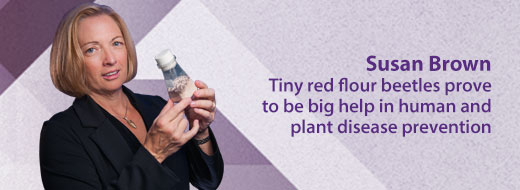
Susan Brown
College of Arts and Sciences
Division of Biology, university distinguished professor
Director of the Arthropod Genomic Center, Bioinformatics Center
'Right to the chase'
Susan Brown has big aspirations for tiny red flour beetles. Brown, a university distinguished professor in the Division of Biology, studies the insect's genomics, bioinformatics and the evolution of gene regulatory networks.
"You can study an organism at many different levels," Brown says. "You can look at its basic biology and how the organism lives, or you can look at molecules, the enzymes and proteins encoded in its genes that help it do things such as grow and develop, digest food or be immune to a disease. My focus is on the latter; I'm going right to the chase."
On the map
Brown's work with the insect has helped put Kansas State University on the map as world's leader in red flour beetle research. She was key in helping an international team sequence and analyze the insect's genome, which is the genetic blueprint of an organism. Brown says genomes have become an essential tool in 21st century biology and genomes of insects will help scientists reduce human and plant diseases spread by pest insects.
Building a base
Brown directs the university's Arthropod Genomic Center and the Bioinformatics Center. She also developed Agripestbase, a community database that contains genome data for the red flour beetle, Hessian fly and tobacco hornworm, to aid in research.
"Having the information available from insect genomes will allow us to understand the basic biology of insects better, leading to better control of them," says Brown.
A potato chip connection
Her focus doesn't stop with the red flour beetle. Brown is helping lead an insect genomics project called the i5k. It's an initiative to sequence the genomes of 5,000 insects and arthropods. Brown hopes the initiative is as enticing to researchers as savory potato chips.
"I've made the joke that genomes are like Lay's potato chips -- no one can sequence just one," she says. "That Lay's 'betcha can't eat just one' slogan is an outcome I'd like to see in the scientific community. Once one genome is sequenced, researchers will want to sequence another that's closely related and compare them."
Mapping the future
Brown says her interest in genomics led her to establish a novel genome mapping technology in her lab that is based on imaging long molecules of DNA that are over 100k in length. "We use these whole genome maps to validate and improve genome assemblies that are based on sequence data," Brown says. "We can also identify structural differences between two genomes, such as normal and disease states, or differences that occur during evolution. Every genome assembly needs a map."
"It's so interesting that for two organisms with mostly the same sets of genes, one could be a beetle and one could be a fly," Brown says. "It's a big generalization, but those differences come from when and where the genes are expressed. For me, understanding those genes and the unique traits they cause will never stop being fascinating."